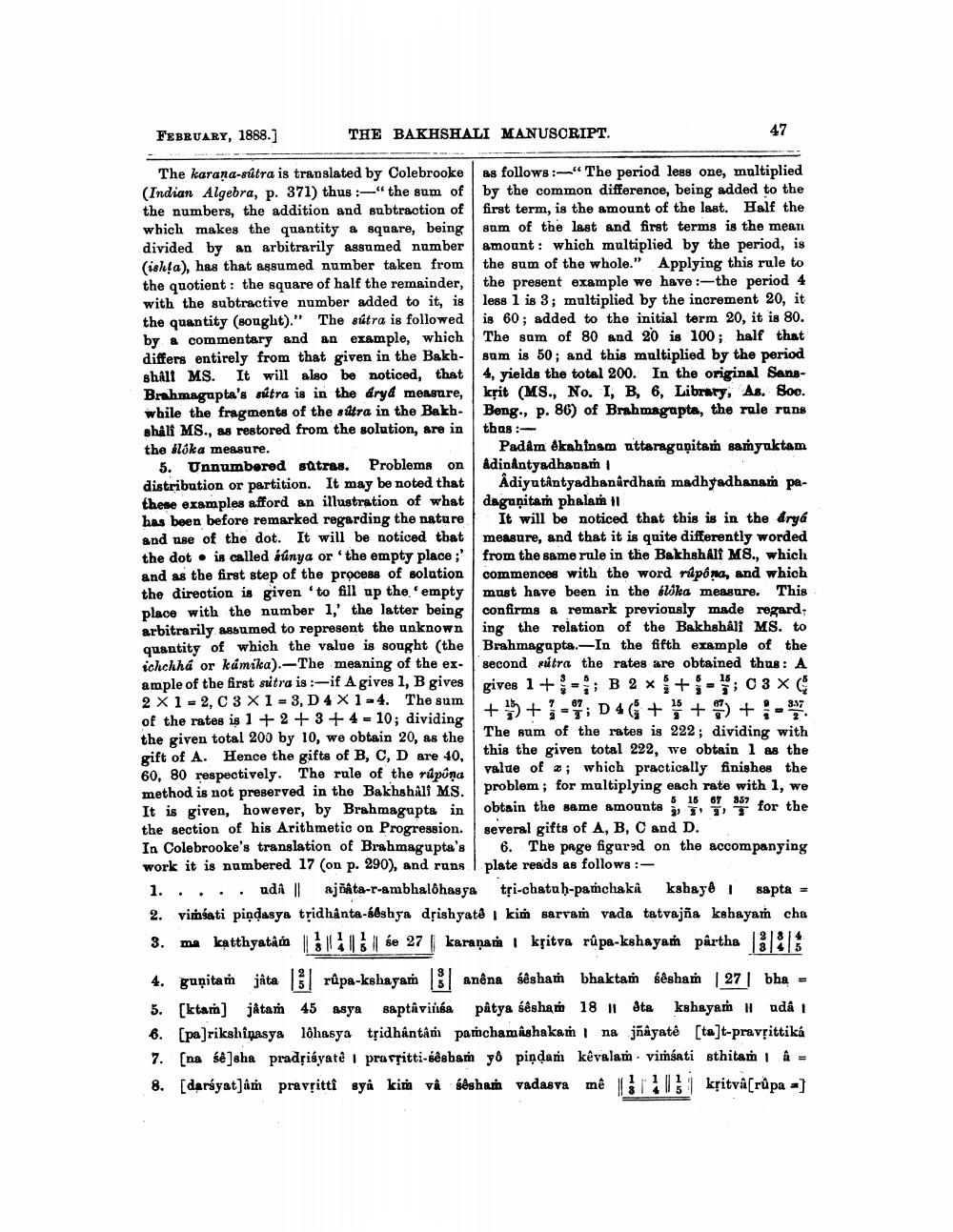________________
FEBRUARY, 1888.]
THE BAKHSHALI MANUSCRIPT.
47
The karana-sitra is translated by Colebrooke as follows:-"The period less one, multiplied (Indian Algebra, p. 371) thus :-"the sum of by the common difference, being added to the the numbers, the addition and subtraction of first term, is the amount of the last. Half the which makes the quantity a square, being sum of the last and first terms is the mean divided by an arbitrarily assumed number amount : which multiplied by the period, is (ishfa), has that assumed number taken from the sum of the whole." Applying this rule to the quotient: the square of half the remainder, the present example we have :-the period 4 with the subtractive number added to it, is less 1 is 3; multiplied by the increment 20, it the quantity (sought)." The sstra is followed is 60; added to the initial term 20, it is 80. by a commentary and an example, which the som of 80 and 20 is 100; half that differs entirely from that given in the Bakh- sum is 50; and this multiplied by the period shalt MS. It will also be noticed, that 4, yields the total 200. In the original SansBrahmagapta's sútra is in the dryd measure, krit (MS., No. I, B, 6, Library, As. Soc. while the fragments of the sidra in the Bakh- Beng., p. 86) of Brahmagapta, the rule runs shali MS., as restored from the solution, are in thas: the slók a measure.
Padâm ekshinam uttaragupita samyuktam 5. Unnumbered satras. Problems on &dinantyadharaம் | distribution or partition. It may be noted that | Adiyutântyadhanardham madhyadhanam pathese examples afford an illustration of what dagaạitam phalan 11 has been before remarked regarding the nature It will be noticed that this is in the drya and use of the dot. It will be noticed that measure, and that it is quite differently worded the dot is called súnya or the empty place;' from the same rule in the BakhshAlt M8., which and as the first step of the process of solution commences with the word ripona, and which the direction is given to fill up the empty must have been in the blbka measure. This place with the number 1,' the latter being confirms a remark previously made regard arbitrarily assumed to represent the unknown ing the relation of the BakhshAli MS. to quantity of which the value is sought (the Brahmagupta.-In the fifth example of the ichchha or kámika).-The meaning of the ex- second sutra the rates are obtained thus: A ample of the first sutra is :-if A gives 1, B gives gives 1+ ; B2x +-;3X 2 X 1-2, C 3 X 1 - 3, D 4X 1-4. The sum
+ + ; D 4 + " + of the rates is 1+ 2+ 3+ 4 = 10; dividing
+ - the given total 200 by 10, we obtain 20, as the
The sum of the rates is 222 ; dividing with gift of A. Hence the gifts of B, C, D are 40,
this the given total 222, we obtain l as the 60, 80 respectively. The rule of the rupóna
value of ; which practically finishes the method is not preserved in the Bakhshall MS. problem ; for multiplying each rate with 1, we It is given, however, by Brahmagupts in obtain the same amounts
for the the section of his Arithmetic on Progression. several gifts of A, B, C and D. In Colebrooke's translation of Brahmagupta's 6. The page figured on the accompanying work it is numbered 17 (on p. 290), and runs plate reads as follows:
1. .... uda || ajñâta-r-ambhalohasya tại-chatuh-panchaka kshayê sapta = 2. vimsati piņdasya tridhậnta-séshya dsishyatë 1 kin sarvam vada tatvajña kshayam cha 3. ma katthyatâia | še 27 karaṇam 1 ksitva rûpa-kshayaṁ pârtha 38
guņita jậta | rûpa-kshayam a nêna śêsham bhaktań sêshaṁ 27 bha = 5. [ktarin) játam 45 asya saptâviisa pâtya śêsha 18 | dta kshayam # udâ 1 6. (pa]rikshinasya lôhasya tạidhântâm pamchamashakam na jñkyatê [ta]t-pravrittiká 7. [na sé]aha pradpisyaté prassitti-sêsbam yo piņdam kêvalam. vimsati sthitam & - 8. [dansyat]ân pravritti spa kia vì đênhan vada va mê | 11 | 2 | kritva_rupa =]




